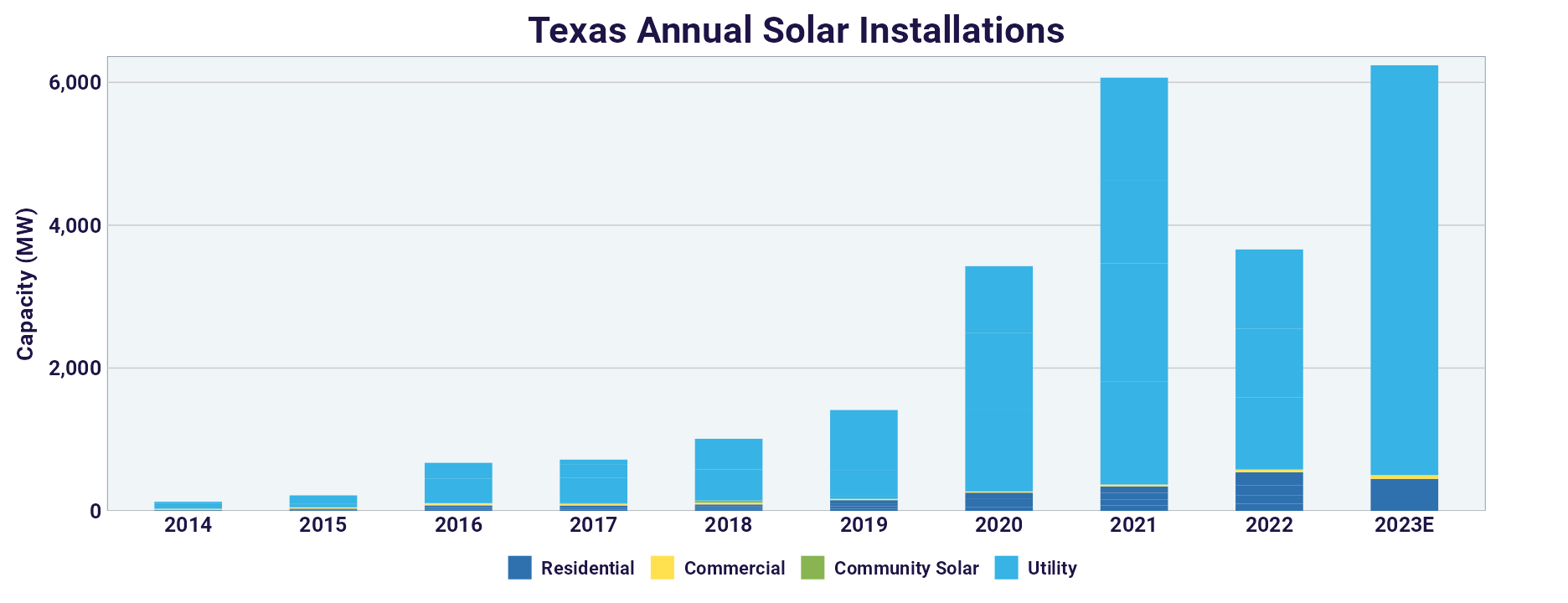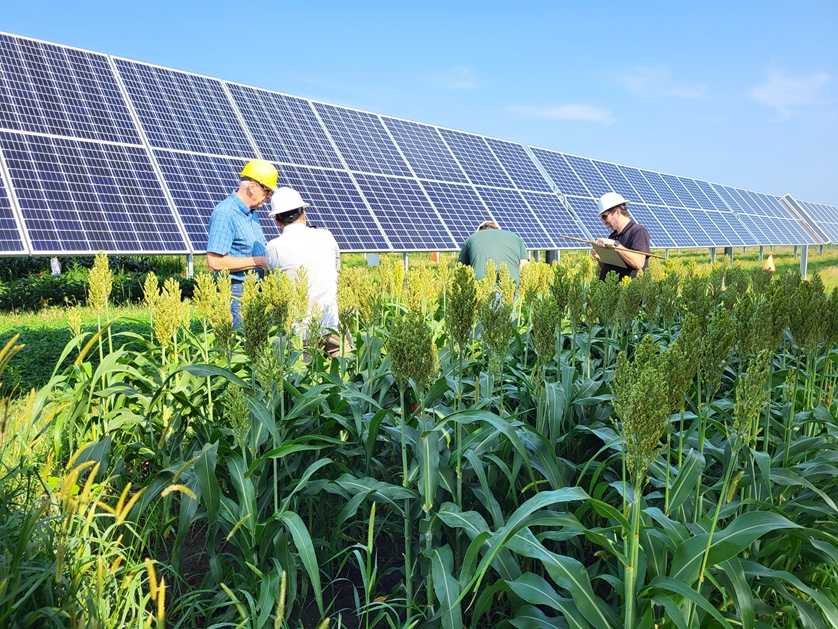Scientists with Texas A&M AgriLife are taking a look at agrivoltaics as a potential solution to the growing demand for both electricity and food.
Agrivoltaics is the practice of pairing solar energy and agricultural production on the same land. As the economy and population in Texas grows, so does its demand on the electrical power grid as well as its demand for sustainable food production. The researchers find that agrivoltaics offers the potential to enhance the efficiency of both.
A large number of coal plants were retired in 2018 and solar has been on the upswing ever since. The state had enough solar installed by Q3 2023 to power 2.5 million homes. Over 11,000 Texans are employed by the solar industry, and the Solar Energy Industries Association (SEIA) reports that over $24.4 billion has been invested in the technology there through Q3 2023. Just over 5% of Texas electricity is generated by PV. SEIA estimates 40 GW to be installed over the next 5 years, putting Texas first in the nation in solar power generation.
Texas is now one of only two U.S. states with a population of 30 million or more: the nation’s second-most-populous state reached a population milestone by passing the 30-million threshold.

According to the U.S. Census, the population in Texas grew 43% from 2000 to 2022, making it the fourth fastest growing state in the country. It is now one of only two states with a population over 30 million; Texas’s population in 2022 was 30,029,572 with only California topping it at 39,029,342.
Not surprisingly, with that growth comes increased demand. The Electric Reliability Council of Texas (ERCOT) reported an unofficial record demand of 85 GW during the summer heatwave of 2023.
“As the population of Texas continues to grow, we will see limitations in the amount of land available for the production of food and other agricultural commodities,” said Dr. Nuria Gomez-Casanovas, assistant professor in regenerative system ecology in the Texas A&M College of Agriculture and Life Sciences Department of Rangeland, Wildlife and Fisheries Management.
The Texas A&M team is taking a look at the potential for agrivoltaics as a result of the growing loss of agricultural lands, coupled with expanding energy requirements, according to Gomez-Casanovas.
The team collaborated with researchers from across the country on a recent paper Knowns, Uncertainties and Challenges in Agrivoltaics to Sustainably Intensify Energy and Food Production, published in Cell Reports Physical Science.
With an understanding that agrivoltaics has the potential to enhance the sustainability of agricultural land while helping to meet energy and food demands, the research focused on the challenges including the ecological, environmental, and socio-economic consequences of agrivoltaics.
Enhanced land productivity
“We reviewed existing scientific literature to assess how agrivoltaics can provide synergistic benefits across the food-energy-water nexus compared to solar power arrays or agricultural systems alone,” Gomez-Casanovas said. “One of the take-home messages from our analysis is enhanced land productivity through the implementation of agrivoltaics.”
Agrivoltaics can reduce the competition for land resources and can minimize or “avoid the unintended negative consequences of conventional solar energy deployment” with smart decision making.
“The idea is to make each acre more profitable for landowners and agricultural operations,” said Gomez-Casanovas.
Using the land equivalency ratio, the researchers found that planting agricultural crops under solar panel arrays can enhance land productivity by up to 60% compared to crop monocultures or solar panel arrays on the same land area.
While land is usually heavily graded before solar is installed, with agrivoltaics vegetation is planted under the solar arrays.
“In a photovoltaic system, vegetation is often removed or kept low under the solar panels, which can result in biodiversity loss associated with land conversion and clearing, as well as an increase in local temperatures due to what is known as the photovoltaic heat island effect,” said Gomez-Casanovas.
Reduction in water loss
Most of the large-scale solar development in Texas is happening in the wide open, arid regions amenable more to cattle grazing than agriculture. Gomez-Casanovas said agrivoltaic systems could boost solar energy production and agricultural resiliency in semi-arid regions of the state.
“Because the solar panels provide shade to the plants, less solar radiation reaches them, resulting in a reduction in soil water evaporation and plant transpiration,” Gomez-Casanovas said. “This is very beneficial for plant health during intense summers and periods of drought.”
Other agrivoltaic studies, such as one conducted by Oregon State’s College of Agricultural Sciences, have noted a reduction in water loss. According to Chad Higgins, an associate professor in Oregon State’s College of Agricultural Sciences and the senior author of the paper published in the journal Sustainability, “Agrivoltaics provide a rare chance for true synergy: more food, more energy, lower water demand, lower carbon emissions, and more prosperous rural communities.”
Reduction in water loss is important in Texas, as water becomes an increasing challenge, and the Texas study notes that the reduction in plant water loss ultimately translates to water savings in irrigation, an important factor for agricultural production.
“Although shading might be expected to lower plant productivity, and it does in certain agricultural settings, there is increasing evidence that agrivoltaics has the potential to enhance crop and forage yields compared to traditional agricultural systems alone,” said Gomez-Casanovas.
In a 2019 study conducted by the U.S. Department of Energy’s National Renewable Energy Laboratory (NREL) and co-authors from the University of Arizona and University of Maryland studied the potential benefits of agrivoltaics on food production, irrigation water requirements, and energy production. The study, published in Nature Sustainability, found a two-fold increase in yields from tomato and chiltepin peppers grown under solar panels in a semi-arid environment compared to a traditional agricultural system.
The Texas A&M researcher, Gomez-Casanovs noted, however, that more research is needed to understand how to enhance crop yields under solar panels because different plant species have varying light requirements. She added that animals can also benefit from the shade provided by solar panels, potentially reducing heat stress in the livestock.
Carbon sequestration
The team also studied the potential for increased carbon sequestration, seeking to increase to increase the body of knowledge around this important benefit. In 2021 a study was conducted by researchers from the U.S. Department of Energy’s Argonne National Lab, NREL and University of Minnesota, which analyzed solar power facilities that integrate natural grasses. The study modeled and averaged solar facilities in seven states in the Upper Midwest. Their modeling suggested that native grasses planted as part of 10 GW of solar generation capacity would sequester 129.3 tons of carbon per hectare; that is 65% and 35% greater than either an agriculture or a solar-turfgrass scenario, respectively.
The Texas A&M study expands on this knowledge, finding that prior land use is a key factor in predicting the impact of agrivoltaics on carbon accrual.
“For example, if you transition a native rangeland to an agrivoltaic system, there is a detrimental impact on carbon sequestration,” said Gomez-Casanovas. “However, if you transition from an agricultural system with low soil organic carbon to an agrivoltaic system promoting carbon buildup, there would be a positive impact.”
Types of plants, soil and agricultural practices can also influence the level of carbon sequestration at agrivoltaic sites, the study suggests. Strategic management, which might include restoring native vegetation or planning pollinator-friendly crops, can affect biodiversity, according to Gomez-Casanovas.
Strategic management of vegetation under the arrays, such as the restoration of native vegetation or planting pollinator-friendly species can also have a positive impact on biodiversity, Gomez-Casanovas said.
One of the challenges to implementing an agrivoltaic system is the significant upfront cost with a long-term investment window, the study finds. These costs are attributed to the infrastructure needed—not only the solar panels and racking, but energy storage and transmission, as well as crop selection. Other areas requiring more insight, the researchers say, include the optimal solar array configuration and policy support that will make agrivoltaics as competitive as possible.
“The profitability of agrivoltaics is expected to play an important role in farmers’ decisions to adopt the system,” Gomez-Casanovas said. “At this point, we have more questions than answers, which is exciting because these questions will guide our future cross-discipline research.”
This content is protected by copyright and may not be reused. If you want to cooperate with us and would like to reuse some of our content, please contact: editors@pv-magazine.com.









By submitting this form you agree to pv magazine using your data for the purposes of publishing your comment.
Your personal data will only be disclosed or otherwise transmitted to third parties for the purposes of spam filtering or if this is necessary for technical maintenance of the website. Any other transfer to third parties will not take place unless this is justified on the basis of applicable data protection regulations or if pv magazine is legally obliged to do so.
You may revoke this consent at any time with effect for the future, in which case your personal data will be deleted immediately. Otherwise, your data will be deleted if pv magazine has processed your request or the purpose of data storage is fulfilled.
Further information on data privacy can be found in our Data Protection Policy.